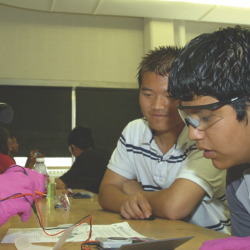Article contents
Offering engaging educational programs for K–12 students (ages 5–18): Examples, perspectives, and recommendations
Published online by Cambridge University Press: 27 April 2011
Abstract

Educational outreach efforts for K–12 students, ages 5–18, are becoming increasingly visible, active, and pervasive in the materials science community as a result of funding agency requirements in the United States and gradual institutional attitudinal shifts toward placing a higher emphasis on engaging non-technical audiences. Many scientists recognize it as both an obligation and a pleasure to share their research with young audiences. However, in addition to enthusiasm and funding agency mandates, equally essential to successful educational outreach projects are effective, engaging educational materials and programs. Hands-on demonstrations, classroom lesson plans, summer research internships, and education-oriented laboratory experiments are just a few examples of the wide variety of possibilities from which materials scientist educators can currently choose. This article addresses the process of developing educational outreach activities and programs, including setting goals, establishing partnerships, and planning for and implementing outreach activities for students. Examples from the materials science outreach community are integrated to illustrate implementations of these ideas and to offer ideas for collaborations and future projects.
- Type
- Research Article
- Information
- MRS Bulletin , Volume 36 , Issue 4: Addressing broader impacts through K–12 outreach in materials education , April 2011 , pp. 271 - 277
- Copyright
- Copyright © Materials Research Society 2011
References
- 1
- Cited by




